Sanders Aeronautics
History
About us
Meet the Founders
HISTORY
Sanders Aeronautics was founded in 1970 by Frank Sanders and his wife, Ruth, in Long Beach, CA. Frank was an avid car drag racer and co-owner of S&S Headers – a high-end fabrication shop specializing in custom headers for drag racers. Son of a WWII pilot, Frank shared his father’s passion for aviation, and had owned a T-6 and a P-51 through the 1960’s.
In 1970 Frank and Ruth decided to sell S&S Headers to their partner, and founded Frank Sanders Aircraft, turning a lifelong passion into a business. Frank took on the extensive repairs required for Cliff Cumming’s P-51 Miss Candace after it was damaged in an off-field landing at the Reno Air Races. Frank’s first full restoration project was Sue Parrish’s P-40 (Currently on display at the Kalamazoo Air Zoo museum in Kalamazoo, MI.) In October of 1968 Frank acquired a Hawker Sea Fury, 232, which he would go on to race and win the 1971 California 1000 Air Race in Mojave, CA. Frank and Ruth mentored their two boys, Dennis and Brian, and by the time the company relocated to Chino in 1976, the Sanders family was well established in the warbird community.
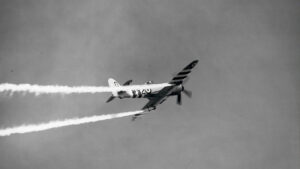 After the untimely death of Frank in 1990, Dennis and Brian became partners with Ruth and continued producing some of the finest aircraft restorations of the era. In 1996, the company moved to its current location of Ione, CA, where they were joined by the third generation of Sanders; Dennis’ daughter Shannon, and her husband Joel Swager. Over five decades of outstanding effort has resulted in the return to airworthiness of over fifty vintage, antique, and warbird airplanes, from damage repairs to complete restorations of everything from Luscombe 8’s to Hawker Sea Furies, to deHavilland Sea Vixens. The team at Sanders Aeronautics continues to offer maintenance and restoration services of the highest caliber.
After the untimely death of Frank in 1990, Dennis and Brian became partners with Ruth and continued producing some of the finest aircraft restorations of the era. In 1996, the company moved to its current location of Ione, CA, where they were joined by the third generation of Sanders; Dennis’ daughter Shannon, and her husband Joel Swager. Over five decades of outstanding effort has resulted in the return to airworthiness of over fifty vintage, antique, and warbird airplanes, from damage repairs to complete restorations of everything from Luscombe 8’s to Hawker Sea Furies, to deHavilland Sea Vixens. The team at Sanders Aeronautics continues to offer maintenance and restoration services of the highest caliber.
Frank Sanders
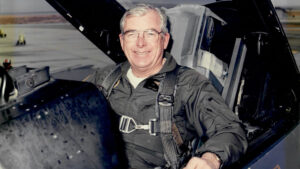
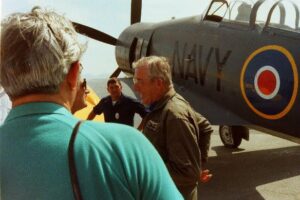 Frank Sanders was the visionary behind Sanders Aeronautics. Brilliantly-minded and hard working, Frank never shied away from a challenge and always sought perfection, setting the standard to which the company still aspires. In addition to being a meticulous aircraft restorer, Frank rebuilt and customized his own engines for racing, including the R-4360 which he installed in the Sanders-built Dreadnought. Frank was also an exceptionally talented pilot, flying his Hawker Sea Fury 924 and Lockheed T-33 Shooting Star to air races and airshows all around the country, and in the 1980s, flying a Marchetti SF-260 in the right-wing position for the aerobatic team, Team America.
Frank Sanders was the visionary behind Sanders Aeronautics. Brilliantly-minded and hard working, Frank never shied away from a challenge and always sought perfection, setting the standard to which the company still aspires. In addition to being a meticulous aircraft restorer, Frank rebuilt and customized his own engines for racing, including the R-4360 which he installed in the Sanders-built Dreadnought. Frank was also an exceptionally talented pilot, flying his Hawker Sea Fury 924 and Lockheed T-33 Shooting Star to air races and airshows all around the country, and in the 1980s, flying a Marchetti SF-260 in the right-wing position for the aerobatic team, Team America.
Frank led the way for Sanders Aeronautics for the first twenty years of operation but was lost in an aircraft accident in 1990. His legacy lives on through the continuation of Sanders Aeronautics as it continues to complete restorations of the highest quality. Frank’s achievements were recognized by the EAA in 2002 when he was posthumously inducted into the Warbird Hall of Fame.
Ruth Sanders
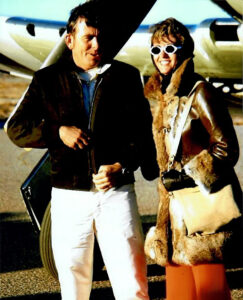
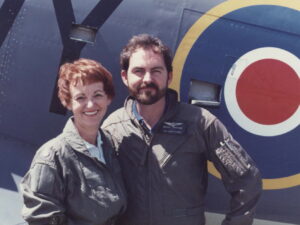 The matriarch of the family, Ruth has been behind every project, and decision in the business. Ruth earned a master’s in business from Arizona State University in 1963 as one of only 2 women in her class. In the company’s infancy, Ruth worked as a school teacher while simultaneously raising their two sons and keeping the books for the family business. As the company grew, managing the books and assets became a full time job and in 1982, Ruth retired from teaching after twenty years.
The matriarch of the family, Ruth has been behind every project, and decision in the business. Ruth earned a master’s in business from Arizona State University in 1963 as one of only 2 women in her class. In the company’s infancy, Ruth worked as a school teacher while simultaneously raising their two sons and keeping the books for the family business. As the company grew, managing the books and assets became a full time job and in 1982, Ruth retired from teaching after twenty years.
With Frank’s passing, she continued to manage the office for her sons. Ruth’s judgment and business savvy proved invaluable as the company continued to grow. Today, Ruth is semi-retired, she keeps a hand in major business decisions and continues to provide guidance to following generations of leadership at Sanders Aeronautics. For her contributions to the Reno Air Races over nearly four decades, she was honored with the Chairman’s Award at the 2021 National Championship event. It is not enough for Ruth to excel in her business, she earned her private pilot’s license in 1975. The “daily driver” was her Beechcraft T-34, putting several hundred hours over 10 years of ownership. While most people in the 1970s piled their kids into the family station wagon for summer vacation, Ruth, and 17 year old Dennis flew the T-34 from Southern California to EAA Air Venture at Oshkosh the summer of 1976 She serves as an inspiration to women in the aviation community.
Great Grand Dame of Air Racing
Dennis Sanders
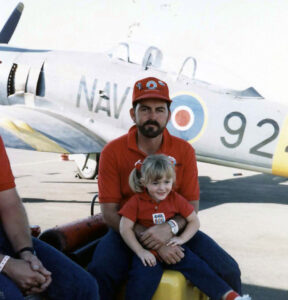
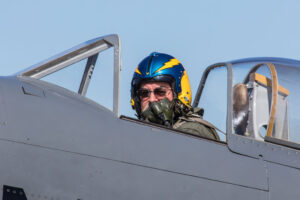 Eldest son of Frank and Ruth, Dennis was completely engrossed by life at the airport. He was eleven years old when the company was founded and has had a hand in every project from its inception, and give you the details of each project to this day. His formative years were spent at the Chino Airport where he was surrounded by all things warbirds and the likes of aviation families such as the Maloneys, Hintons, and Muszalas, he was one of those famously described “Chino Kids.”
Eldest son of Frank and Ruth, Dennis was completely engrossed by life at the airport. He was eleven years old when the company was founded and has had a hand in every project from its inception, and give you the details of each project to this day. His formative years were spent at the Chino Airport where he was surrounded by all things warbirds and the likes of aviation families such as the Maloneys, Hintons, and Muszalas, he was one of those famously described “Chino Kids.”
Dennis’ accolades are extensive, but perhaps most notably he earned a coveted Golden Wrench award at Oshkosh in 1988 for his restoration of a Fiat G.58 for Guido Zuccoli. Like his father, Dennis is an exceptional aviator, beginning his racing career in 1983 at 25 years old, and flying demonstrations in the family Sea Furies in 1988. To date, as both a racer and instructor at Pylon Racing School, Dennis has flown more laps around the Unlimited Racecourse at Reno than any other pilot in history. He’s been dubbed the “Sea Fury King” as he has restored 11 Sea Furies and has accumulated more than 2,000 hours in the type, making him the most experienced Sea Fury pilot of all time.
In 2019, Dennis was inducted into the EAA Warbirds of America Hall of Fame. In addition to being an aircraft restorer, air show performer, and air race champion, Dennis today would best describe his role as an instructor, mentor, and coach. He is still involved daily with the company and is often the first to arrive and the last to leave.
Shannon Sanders-Swager
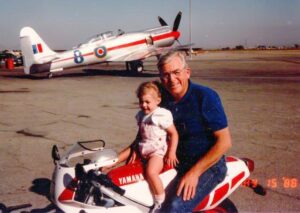
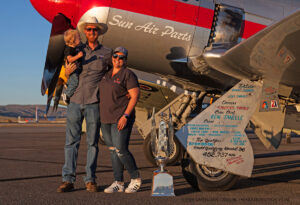 In 2013 Dennis’ daughter Shannon relocated to Sanders HQ with her husband, Joel, and joined the family business. She followed in the footsteps of her grandmother, Ruth, who became a mentor and learned the trade of running the office all the while earning both her Undergraduate and Masters degrees in Business. Shannon has embodied the same level of leadership and management ability as her grandmother, who continues to inspire her. Shannon is advancing the office into the digital age by modernizing processes, expanding capabilities and streamlining the office staff into an efficient team of analysts. Outside of the office, she maintains her involvement in aviation from the ground, volunteering at numerous air shows in California, including Planes of Fame Airshow since her youth, aiding in planning, execution, and logistics, and currently serves as a member of the board of directors for the Unlimited Class for the Reno Air Racing Association.
In 2013 Dennis’ daughter Shannon relocated to Sanders HQ with her husband, Joel, and joined the family business. She followed in the footsteps of her grandmother, Ruth, who became a mentor and learned the trade of running the office all the while earning both her Undergraduate and Masters degrees in Business. Shannon has embodied the same level of leadership and management ability as her grandmother, who continues to inspire her. Shannon is advancing the office into the digital age by modernizing processes, expanding capabilities and streamlining the office staff into an efficient team of analysts. Outside of the office, she maintains her involvement in aviation from the ground, volunteering at numerous air shows in California, including Planes of Fame Airshow since her youth, aiding in planning, execution, and logistics, and currently serves as a member of the board of directors for the Unlimited Class for the Reno Air Racing Association.
Joel Swager
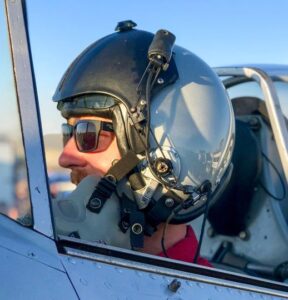
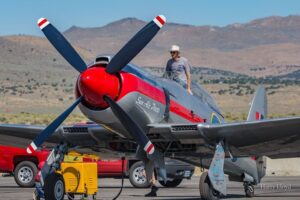 Joel grew up on a dairy farm immediately across the street from the Chino Airport. As a youth, he began volunteering at the Planes of Fame Air Museum, where he received mentorship in warbird restoration. He began working for Steve Hinton’s restoration shop, Fighter Rebuilders after completing high school. While simultaneously working for Fighter Rebuilders and volunteering for the Air Museum, Joel started acquiring multiple pilot’s ratings, his A&P and IA. After years of dedicated service as a volunteer, Joel distinguished himself as a supremely competent mechanic and fabricator. He was allowed to fly the Museum’s P-51 Spam Can, and replica Val Dive bomber among many other aircraft. Dennis has mentored Joel in leadership as he has progressed in the aviation and warbird community, up to and including checking Joel out in the family Sea Fury 924, and eventually Dreadnought. In 2018, Joel piloted Dreadnought to its first victory at the National Championship Air Races since 1986 and again in 2021. Joel runs the day-to-day operations in the shop and remains a great and talented resource for the maintenance of warbirds, and the complex fabrications that are required for modern restorations. Joel is catapulting Sanders Aeronautics into the modern era of fabrication and was recognized by the EAA in 2019 as one of the Top 20 Under 40 in the warbird field.
Joel grew up on a dairy farm immediately across the street from the Chino Airport. As a youth, he began volunteering at the Planes of Fame Air Museum, where he received mentorship in warbird restoration. He began working for Steve Hinton’s restoration shop, Fighter Rebuilders after completing high school. While simultaneously working for Fighter Rebuilders and volunteering for the Air Museum, Joel started acquiring multiple pilot’s ratings, his A&P and IA. After years of dedicated service as a volunteer, Joel distinguished himself as a supremely competent mechanic and fabricator. He was allowed to fly the Museum’s P-51 Spam Can, and replica Val Dive bomber among many other aircraft. Dennis has mentored Joel in leadership as he has progressed in the aviation and warbird community, up to and including checking Joel out in the family Sea Fury 924, and eventually Dreadnought. In 2018, Joel piloted Dreadnought to its first victory at the National Championship Air Races since 1986 and again in 2021. Joel runs the day-to-day operations in the shop and remains a great and talented resource for the maintenance of warbirds, and the complex fabrications that are required for modern restorations. Joel is catapulting Sanders Aeronautics into the modern era of fabrication and was recognized by the EAA in 2019 as one of the Top 20 Under 40 in the warbird field.
Sanders Fleet
924
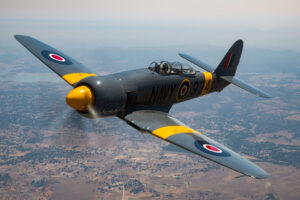 The second Sea Fury to enter the Sanders Fleet did so in 1977, Frank purchased the former German Air Force target tug airplane, from Lloyd Hamilton. Frank outfitted it with the original back seat equipment removed by the Germans and began flying it around the country and ultimately used it to provide dual instruction in the Sea Fury to many of the up and coming generation of warbird pilots, including both of his sons. Through the late ‘70s, ‘80s and ‘90s 924 could be found on the airshow circuit, all around the country, and made semiannual trips to NAS Patuxent River, MD where Frank and Dennis would provide instruction to students of the US Navy Test Pilot School who evaluated the aircraft as part of their curriculum. After an engine failure in 1998, 924 underwent a thorough rebuild of both airframe and engine and re-emerged onto the scene at Reno in 2012. It is one of only four Sea Furies remaining still utilizing the Bristol Centaurus engine, original to the Sea Furies. It is also flown regularly to air show events around California, and races annually at the Reno Air Races every September.
The second Sea Fury to enter the Sanders Fleet did so in 1977, Frank purchased the former German Air Force target tug airplane, from Lloyd Hamilton. Frank outfitted it with the original back seat equipment removed by the Germans and began flying it around the country and ultimately used it to provide dual instruction in the Sea Fury to many of the up and coming generation of warbird pilots, including both of his sons. Through the late ‘70s, ‘80s and ‘90s 924 could be found on the airshow circuit, all around the country, and made semiannual trips to NAS Patuxent River, MD where Frank and Dennis would provide instruction to students of the US Navy Test Pilot School who evaluated the aircraft as part of their curriculum. After an engine failure in 1998, 924 underwent a thorough rebuild of both airframe and engine and re-emerged onto the scene at Reno in 2012. It is one of only four Sea Furies remaining still utilizing the Bristol Centaurus engine, original to the Sea Furies. It is also flown regularly to air show events around California, and races annually at the Reno Air Races every September.
Dreadnought
The family crest. An air racer to his core, Frank Sanders’ vision was to marry the highest performing piston fighter, the Sea Fury, to the largest and most powerful piston aircraft engines ever built, the Pratt and Whitney R-4360. As a cohesive team, Frank, Ruth, Dennis, and Brian worked tirelessly, seven days a week to bring Frank’s vision to life; they enlisted the help of some of the best: Chuck Cabe of Cabe’s Aviation to design and install the entire electrical system, Pete Law – lead thermodynamicist of Lockheed’s Skunk Works – designed the water and alcohol systems, Bob Smith – structural engineer and aerodynamicist for Douglas Aircraft – to design the structural modifications and stability enhancements, and former General Dynamics engineer John Maguire for his aerodynamics and fabrication expertise.
In order to install the 28-cylinder beast onto the Sea Fury, significant modifications had to be made:
- The original 14-gallon oil tank was deleted from the firewall and a custom 28-gallon tank was installed behind the rear seat.
- The intake scoops were deleted from the leading edges of the wings and replaced by a one-of-a-kind induction trunk over the top of the engine.
- A second oil cooler was fitted into the right wing duplicating the stock one in the left.
- The engine mount and cowling was custom built to hold and to house the massive engine.
- An Aero Products propeller from a Skyraider was modified and installed 10” forward of the original location.
- The vertical stabilizer and rudder were lengthened by over a foot to counteract the additional horsepower and torque.
- Water spray-bars were added to the oil coolers, and spray nozzles were installed behind the propeller to cool the cylinders, custom water tanks were built and installed in the gun bays.
- The right wing fuel tank was re-sealed and converted to an Alcohol tank to support the Anti-Detonation Injection system.
Boasting over 4,000 horsepower, Dreadnought arrived on the ramp for the 1983 Reno Air Races ready to win–and it did; setting fastest qualifier records in ‘83, ‘84, ‘85, and ‘86 and bringing home first place victories in ‘83 and ‘86, at speeds of over 450 mph. Dreadnought returned to the top of the podium in the skillful hands of Joel Swager in 2018, again in 2019 with Dennis Sanders at the controls, and most recently Joel returned to the cockpit to finish first in 2021.
Argonaut
In 1986 Dennis began collecting damaged Sea Fury Parts at bargain prices. With unprecedented vision and patience he started straightening, repairing, and fabricating parts. Using fixtures built off of original Hawker factory parts, Dennis slowly began turning piles of parts into an airplane. By the time Argonaut was ready for an engine, the Bristol Centaurus had become very scarce and difficult to support so Dennis hung a Wright R-3350 and paired it with an Aero Products propeller. Dennis performed the first flight in 1994 and Argonaut, despite its significant damage history, proved to be a remarkably straight and well-flying Sea Fury. The high costs of parts and difficulty of overhaul prompted the Sanders to begin looking at other powerplant options for their Sea Fury. Dennis decided to redesign the entire firewall forward of Argonaut with the Pratt and Whitney R-2800 in a manner that was minimally invasive and maintained the original cowling and same propeller as the R-3350. From the outside the airplane appeared unchanged, although the R-2800 produced less horsepower than the R-3350, the -2800 installation proved to be 600 pounds lighter and far more reliable. Since the engine change was completed in 2011 Argonaut has flown nearly four hundred hours without any major problems, competing in the Reno Air Races every September since it was re-engined. To date, three other Sea Furies have been re-engined with the Sanders R-2800 kit.
N3N
Dennis Sanders spent his summers as a kid as a flagger for his uncle George Sanders, a crop duster in Chandler, AZ. George flew Naval Aircraft Factory N3N’s–the metal structured counterpart to the venerable Stearman primary trainer of WWII. Dennis acquired an N3N project from the storage yard of Bob Copeland’s San Tan Dusters, and started reconditioning it, fabricating new parts to replace old and damaged ones. He removed the hopper and sprayer systems and replaced them with new old stock parts that he’d collected over time. What he couldn’t find, he made, from scratch, including both front and rear seats from scratch. Dennis decided that a Wright R-975 should replace the original R-760 and with a few modifications he was able to retain the unique look on an N3N while making nearly double the horsepower. After seven years of weekend work, Dennis flew his N3N on its maiden flight. Today it largely serves as the primary ride hopper. In nearly fifteen years since its restoration was completed, it has flown over 300 hours and given rides to eager volunteers, charity auction bidders, local VIP’s, and even WWII veterans around the foothills of Amador County. It is a flying representation of Dennis’ history, and a source of great pride within the organization.
Notable Restorations
N63SF
N63SF was imported from Iraq by David Tallichet and Ed Jurist in the late 70’s, it sat as an unrestored time capsule and was eventually acquired by Sanders Aeronautics. In 2011, the Sanders family sold N63SF as a project to Chuck Greenhill, who then commissioned Sanders Aircraft to rebuild the dual controlled Sea Fury T.20 with a Pratt and Whitney R-2800 and Aero Products propeller on the front of it. Unfortunately, Chuck’s health took a turn for the worse and he was unable to see the project through to completion, so he sold it nearly finished to Joe Thibodeau of Colorado, for whom the project was completed in 2018. Dennis test flew the Sea Fury after the extensive restoration and together with the Sanders Aeronautics team spent several additional months putting time on the Sea Fury and preparing it for the 2018 Reno Air Races, where Dennis raced it in Sunday’s Unlimited Gold Race.
AT-11
A substantial clean up of this AT-11 was one of the very first projects taken on by Sanders after their move to Chino, CA. Dennis and brother, Brian, still teenagers, began this restoration. The airplane was hardly much older than they were, and no extensive sheet metal work was required, however it had been sitting derelict for many years; the entire airplane was stripped and overhauled. It was converted from a Beech AT-11 to a C-18 in 1958 by Burbank Air Service, Dennis and Brian converted it back to an AT-11, complete with glass nose and Navy paint job. For many years the Sanders family flew the airplane until regretfully selling it to help fund the Dreadnought restoration in 1982.
232
Frank Sanders’ first exploration into the Sea Fury, the king of piston fighters, came when he purchased 232 from Pauline Baird in 1968. Intent on endurance racing and air show flying, Frank assembled the freshly imported Sea Fury and added extra fuel capacity and wingtip smoke generators. Frank flew the airplane at air shows around the country, and won first place in the 1971 California 1000 Air Race in Mojave. In 1978 the family elected to sell 232 but that wasn’t the end of Sanders’ association with the airplane. In 1996 232 was acquired by Mike Brown, who was hell-bent on racing the airplane to a first place finish in the Unlimited division at Reno. In order to do so, he selected Dennis to modify the airplane to make it the fastest Sea Fury in the world. Dennis again enlisted the help of Skunk Works thermodynamicist Pete Law, who designed a boil-off system to use evaporative cooling to cool the oil, rather than dragging a traditional oil cooler through the air. Dennis and his team fitted the airplane with a tiny racing canopy, the same style used on Strega and Voodoo. They installed the Wright R-3350-26WD, a late fuel-injected variant of the -3350, capable of nearly 4,000 horsepower utilizing alcohol injection. Mike Brown rocketed the airplane to the top of the podium at the 2006 Reno Air Races at a speed of 481.619 miles per hour, it remains the fastest Sea Fury of all time.
Critical Mass Sea Fury
Critical Mass was a highly modified Sea Fury owned by the Dwelle family of Auburn, CA. The Sea Fury was flown from the back seat and the entire front cockpit of the T.20 Sea Fury had been gutted and skinned over to reduce weight. A heartbreaking second place finish in 2005 prompted the end of the racing career for Critical Mass and the Dwelle family opted to return the airplane to the stock T.20 configuration. Years of attempts by various owners to reduce weight in pursuit of speed by removing every allowable ounce of structure had taken its toll, and was not acceptable by any modern standard. The Dwelle family contracted Sanders Aeronautics to return the fuselage of Critical Mass to modern standards of airworthiness–it remains one of the most thorough and extensive structural repairs of any Sea Fury to date. Once the structural repairs were complete, the fuselage was returned to the Dwelle family, Ken Dwelle reassembled, plumbed, and finished the Sea Fury. Chuck Cabe was enlisted to wire the airplane and install the radios and Dennis prepared Ken to fly his newly restored Sea Fury by instructing him in 924, and Ken performed the first flight of his stock Sea Fury in 2018.
Yak-11
By 1987, Dennis was no stranger to replacing foreign engines and systems with supportable and similarly functioning components. So when good friend, Planes of Fame pilot, Joe Haley came to Dennis looking for help turning his Yak-11 project into a viable budget-friendly piston fighter, Dennis couldn’t resist. Only Americanizing where absolutely necessary, Dennis built a custom engine mount to hold a Pratt & Whitney R-2000, cowling mounts, and exhaust. He was able to retain all of the original Yakovlev lines while making it familiar to any pilot versed in American piston fighters. The R-2000 offered considerably more horsepower than its original Russian engine. After Dennis performed the first flight everyone was delighted to find out that the budget fighter could run with a P-51, while costing a fraction to own and operate.
Fiat G.59
Guido Zuccoli purchased a project Fiat G.59 in 1985 and looked to Sanders Aeronautics to turn it into a flying warbird. Resurrecting an airplane of such rarity is exceedingly difficult. There were no other projects from which to repurpose parts or even to use as a reference. Dennis began the painstaking process of retrofitting components from other airplanes to replace what was irreparable. He designed the systems himself, utilizing a blend of original Italian parts and more readily available ones including replacing the original Fiat radiator door actuator with a modified P-51 radiator door actuator, making the Fiat much easier to support. In 1988 Dennis finished work on the Fiat, and for the first time since WWII, returned a G.59 to the skies. He ironed out all the kinks and took it to EAA Airventure in Oshkosh, WI, where it was named Judges Choice, and Dennis was awarded a Golden Wrench award for craftsmanship.
CAC Boomerang
Among the most unique airplanes built by Sanders was the Commonwealth Aircraft Corporation’s Boomerang. The Boomerang is largely forgotten by history but remains a proud achievement of the Australian peoples’ contribution to WWII–it was the only fighter designed, built, and operated by Australians during the war. It was based on the North American T-6, which was being built under license by CAC–but boasted a Pratt and Whitney R-1830 instead of the standard R-1340. Guido Zuccoli, a proud Australian, became a repeat customer of Sanders Aeronautics–he wanted a Boomerang, but there were no Boomerangs available. Dennis started with an original Boomerang tube frame, but was unable to source many of the original Boomerang parts. What he couldn’t find, he modified from readily available T-6 parts. He clipped the wings over two and a half feet on each side, built custom ailerons that extended into what had been the flap well. Every brazier-head rivet on the fuselage was drilled, its hole dimpled, and replaced by a flush rivet. The firewall forward was completely redesigned to accommodate the large size of the R-1830. When it was completed, Dennis performed the first flight. Weighing in at less than 6,000 pounds, the Boomerang boasted nearly 1,500 horsepower, giving it greater power-to-weight ratio than a P-51.
FG1D Corsair
This Corsair was sold as surplus for $3,000 in 1958 to Cupples Products who used it as a wind machine to test glass panels in Missouri. The Corsair suffered greatly in its new role; its wings were cut off by torch to fit onto a flatbed truck, the aft fuselage and tail were removed and scrapped, the cockpit was stripped of all components not required to run the engine. After its use as a wind machine, it suffered decades of neglect and changed hands several times until it was acquired by the Sanders family in 2011. The project was completely disassembled and extensive corrosion and damage was found in the center section spar. New spar caps were extruded and bent to fit the irregular shape of the Corsair wings and slowly the airplane began to take shape as individual parts were overhauled, repaired, or fabricated and attached to the spar. Longerons were made anew and the cockpit section was built around them and was fit to the center section. Horizontal stabilizers were built from scratch and new spars, ribs, and skins are currently being produced in order to rebuild the extensively damaged outer wings. The Corsair project is currently underway and will be an outstanding testament to the dedication and craftsmanship of the team at Sanders Aeronautics
Testimonials
What Our Customers Say
Sanders Aeronautics has worked with world-wide aviation customes with the following amazing testimonials to honor our brand…
Excellent Service
US Navy
Without the help of Sanders Aeronautics, we could never have gotten our F-18 to fly.
Cody McClure
Professional Service
US Air Force
Sanders Aeronautics developed a custom smoke generator for our stealth bomber in less than 3 hours.
Billy Bob
Get in touch
Let’s Get Connected
Have questions or maybe an idea on a custom part? Contact us today!
Copyright ©2023 Sanders Aeronautics. All Rights Reserved.
